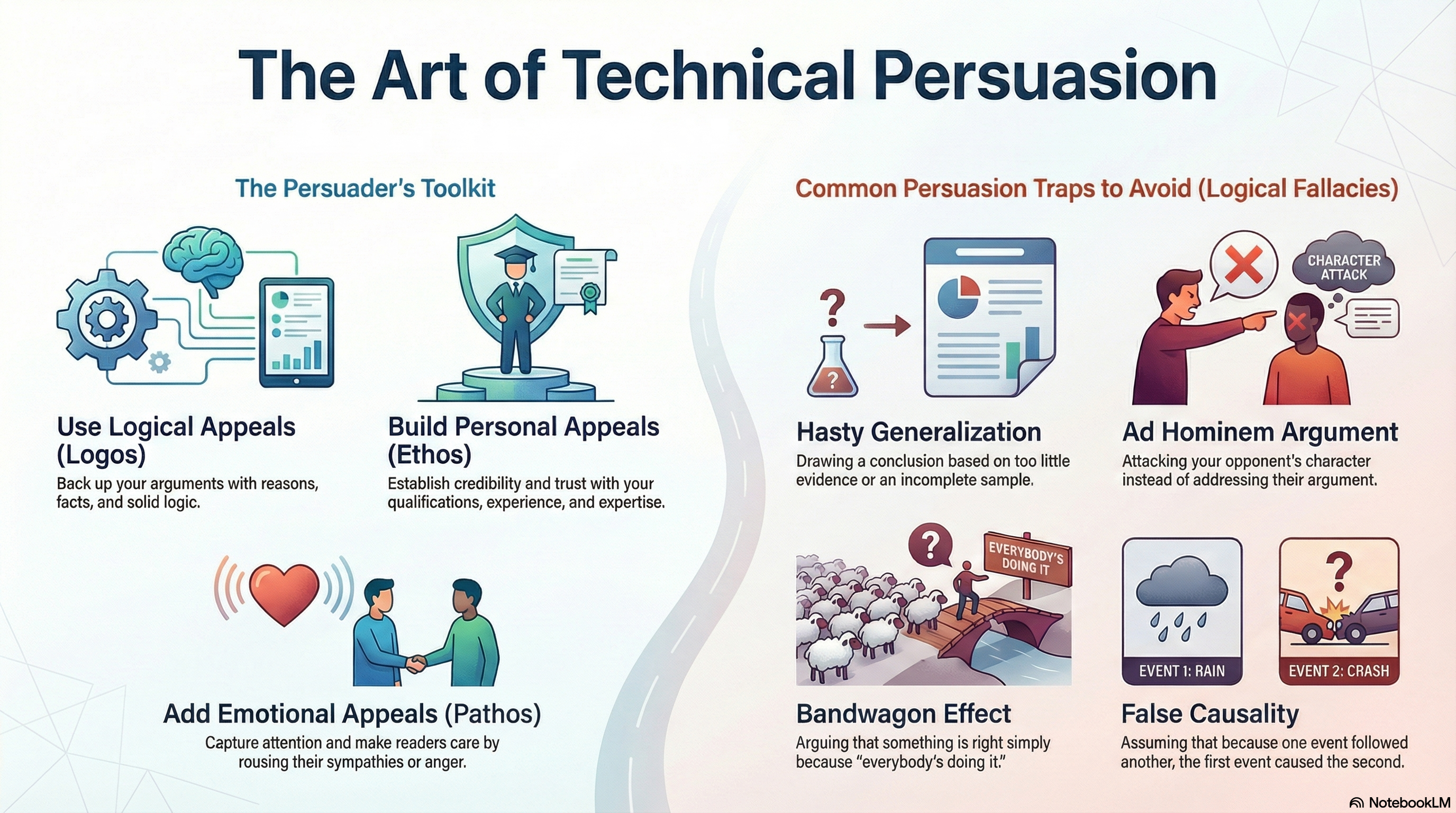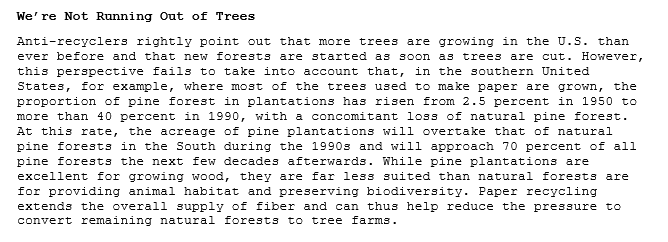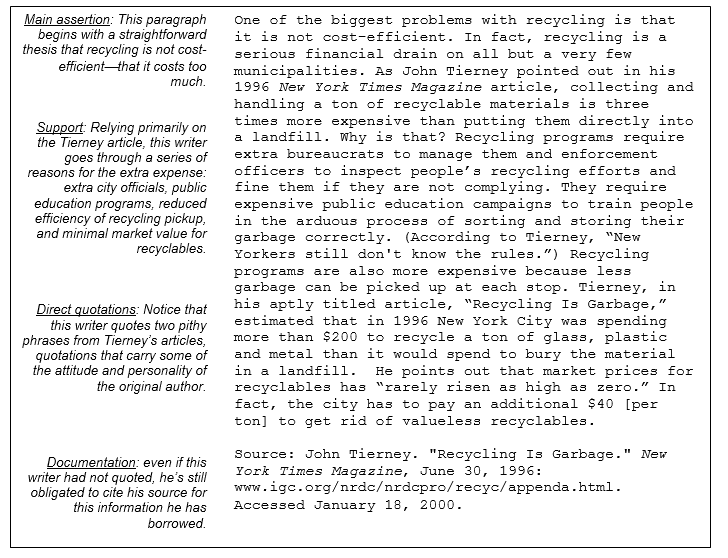Please click here to help David McMurrey pay for web hosting:
Donate any small amount you can !
Online Technical Writing will remain free.
When the teaching of technical writing first emerged in university engineering schools, it was defined as rigorously objective in writing style—even to the extent of using the passive voice instead of the first-person singular "I." The standard model was the primary research report. However, since then, we've recognized that technical communication is much more than the primary research report. In this larger perspective, it has become clear that technical writers must often engage in persuasive communication efforts in their primary work.
What Is Persuasion?
The infrastructure essential in proposals and progress reports is persuasion. To convince people to hire you to do a project and to reassure them that the project is going well, you need persuasive strategies. This chapter reviews the common persuasive strategies to get you ready to write those kinds of documents—as well as persuasive technical documents. Understanding general persuasive writing strategies, you will be well-equipped to develop these kinds of documents:
Note: See examples of persuasion.
Persuasion is the communicative effort to convince people to think a certain way or act a certain way—for example, to vote for a city-wide recycling program, to oppose the building of more coal-fired electricity plants, and so on—or the opposite!
In the view of some, persuasion is not a legitimate tool for technical communication. For them, technical writing is supposed to be "scientific," "objective," "neutral." However, if you grant that proposals, progress reports, resumes, application letters, and even complaint letters are instances of technical communication because they often must convey technical information, then you see that persuasion is an important tool in technical communication.
References:
- Monroe's Motivated Sequence. Changing Works, 2002-2018.
- Toulmin Method. Purdue OWL.
- Aristotle's Rhetoric. Massachusetts Institute of Technology Classics.

What Are the Tools of Persuasion?
The classical approach to persuasion, laid down my Aristotle (384 – 322 BCE) in the Art of Rhetoric, involves these appeals to readers and listeners (remember your Rhetoric and Composition 101?):
- Logical appeal—When you use reasons and arguments, backed up by facts and logic, to make your case, you are using the logical appeal. We normally think of the logical appeal as the only legitimate method of argument, but the "real world" shows us differently.
- Emotional appeal—When you attempt to rouse people's anger or sympathies in a persuasive effort, you are using the emotional appeal. Showing a little girl fleeing from a burning village bombed by war planes or an oil-soaked seagull on a beach devastated by an oil spill—these images spark emotions like anger, horror, sympathy; but they don't make a logical case for or against anything. These images may, however, capture readers' attention and cause them to pay more attention to the rest of your persuasive effort.
- Personal appeal—When you present your qualifications, experience, expertise, and wisdom or those others, attempting to build readers' confidence, you are using the personal appeal. As with the emotional appeal, there is no logical justification for the personal appeal. It's like saying, "Trust me." Despite that, readers sometimes want to know who you are and what gives you the right to speak so authoritatively on the subject. Just as the emotional appeal can be used legitimately to get readers to pay attention and care about your message, the right amount of personal appeal can build readers' confidence in you—or at least a willingness to hear you out.
You may also have encountered the "stylistic" appeal: the use of language and visual effects to increase the persuasive impact. For example, a glossy, fancy design for a resume can have a positive impact just as much as the content.
In your rhetoric and composition studies, you may also have encountered something called the Toulmin approach to persuasion. The complete system involves claims, grounds, warrant, backing, and rebuttal, but a particularly useful element is the rebuttal, and another known as the concession.
- Rebuttal. In a rebuttal, you directly address counter-arguments that your persuasive opponents might bring up. You show how they are wrong or, at least, how they don't affect your overall argument. Picture yourself face to face with your persuasive opponents—what arguments are they going to come back at you with? How are you going to answer those arguments? In a written persuasive effort, you must simulate this back-and-forth, debate-style argumentative process. Imagine your opponents' counter-arguments (arguments they might put forth against your position) and then imagine your own rebuttals (your answers to those counter-arguments).
- Counter-argument. A persuasion can be structured entirely around tearing down the opponent's argument. Consider this example:

Example of a counter-argument. The paragraph begins by repeating an argument against recycling, then concedes a certain truth to it, but ends by showing that it is irrelevant.
See the complete example. - Concession. In a concession, you acknowledge that certain opposing arguments have some validity, but you explain how they do not damage your overall argument. Concessions build personal appeal: they make you seem more open minded.
- Synthesis. Modern rhetoricians urge us not to view the persuasive process as a win-lose, all-out war. When people are entrenched, they shut out the arguments of the other side. Such rigidity prevents us from resolving the issue and getting on with our lives. Instead, the process of counter-argument, rebuttal, and concession should be sincere and continuous until all parties reach synthesis—a middle ground where they drop their weapons and agree.

Single-paragraph example of persuasion. This paragraph would be one of several paragraphs attempting to discredit the recycling movement.
What Are the Common Flaws in Persuasion?
You should be aware too of the logical fallacies commonly found in persuasive efforts:
- Hasty generalizations. When you draw a conclusion based on too little evidence, that's a hasty generalization. For example, if you conclude that there is a big social trend to return to the 70's look because you see two or three bellbottoms and paisley shirts one day, you've drawn a hasty generalization based on a very limited, incomplete sample.
- Irrelevant, ad hominem arguments. When you base all or part of your persuasive effort on your opponent's character, behavior, or past, that's an ad hominem argument (meaning "to the man" in Latin). If a middle-aged political candidate were attacked for smoking marijuana in college, that might be an irrelevant personal attack.
- Bandwagon effect. If you base all or part of your persuasive effort on the idea that "everybody's doing it," you're using the bandwagon effect. Commercial advertisement commonly uses this tactic: everybody's buying the product—so should you!
- False causality. If you argue that because one event came after another, the first event caused the second, you may be making an argument based on false causality. For example, imagine that your father joined IBM in 1984 as a low-level regular employee and shortly thereafter the company began its historic slide to near-extinction. Imagine further that in 1995 he left the company, at which time the company began its remarkable comeback. Was it your dad who nearly brought the company to its knees? Did his departure save the company?
- Oversimplistic, either – or arguments. If you reduce the choices to the one you favor and to a totally unacceptable one, you are using an oversimplistic, either – or argument. Advocates of the nuclear power plant might argue that either we build the thing or we go without electricity
- False analogies. When you compare a situation to a simple object or process, that's an analogy. When you base an entire persuasive effort on an analogy, you may have problems. Some analogies are just wrong to begin with. And, at some point, all analogies break down. For example, arguments relating to global warming often use the analogy of how a car heats up when the windows are rolled up. The Vietnam war was justified using the analogy of how dominoes all topple over when they are lined up. Analogies can help readers understand, but not justify an argument.
How to Write a Persuasive Document
Here are guidelines on writing persuasively in a technical-writing content:
- Carefully pick your topic and your approach to it. Finding a project for persuasion is like trying to pick a fight. Think of the main issues of the day—global warming, ozone-layer depletion, alternative fuels, mass transportation, pesticides, zero population growth, solar energy, cloning (bioengineering), abortion, effects of computer- and video-game violence, capital punishment, nuclear armaments, chemical warfare. Each of these topics has multiple issues that are hotly debated. Technical-writing courses are not the place for the common pro-and-con and letter-to-the editor essays you may have written in past writing courses. However, these topics have a technical side that challenges your abilities as a technical writer.
What are the logical arguments for recycling — more specifically, a city-based curb-side recycling program? They range from altruistic (for the city, for the planet) to selfish (to reduce waste management costs, to decrease taxes). Which arguments you use depends on your readers. Altruistic arguments may be of no use to certain conservative or business readers or to city administrators, but they may be vital in getting ordinary citizens to back such the program. - Define each of your arguments; plan how you will support them. You must prove each logical argument, using supporting data, reasoning, and examples. You can't just baldly state that something costs less, works better, provides benefits, and is acceptable to the public—you've got to prove it!
In your persuasive effort to get the city to consider recycling, you might use the logical appeal that such a program would reduce landfill requirements. How can you prove that? Do some research. What's the city's daily input to the landfill; what are the costs? Can you determine the percent made up by recyclables? If you can get believable numbers, calculate landfill savings in terms of volume and dollars. - Consider emotional appeals. At best, emotional appeals capture readers' attention and get them to care about the issue. At worst, they rouse strong emotions such as fear and anger, preventing readers from thinking clearly about the issue.
What emotional appeals could you use for the recycling promotion (not that you actually would, of course)? Images of overflowing landfills might work; images of dwindling natural habitats, replete with deer, chipmunks, hummingbirds — these might work. Would they pull at the heart strings of your readers, or would readers cynically mutter "give me a break"? How would you feel about using such tactics? - Consider personal appeals. Like emotional appeals, personal appeals have no logical relevance to an argument. If you use the personal appeal, you attempt to build readers' confidence in you as someone who is knowledgeable and reliable. Citing years of experience and education is a common example of building a personal appeal.
What personal appeals could this recycling persuasion use? To get people to accept your data, cite believable sources, such as government reports or leading experts. To give yourself credibility, describe your past experience and training in this area. Perhaps also describe yourself as a long-time resident of the city. These appeals shouldn't have any relevance, but they may cause people to hear you out. - Address any counter-arguments. It's a good idea to address counter-arguments—objections people might raise in relation to your argument. Imagine people out there saying "but—but—but—!" Discuss their counter-arguments and show how they are wrong, how they can be addressed, or how they are irrelevant to your main point. Notice that the persuasive document advocating recycling is structured on counter-arguments:
Recycling: Not a Waste of Money or Time!
As for recycling programs, you must address the standard objections. It's a hassle. Your might counter-argue that recycling is no more of a hassle than taking out the garbage. It's a hassle sorting everything and keeping in separate bins. That one is easy——most recycling programs don't require sorting. It's messy and attracts pests. Hmmm, that's a hard one — time for some research. - Plan an introduction. In an introduction to a persuasion, you cannot start out guns blazing and swords rattling. It's not necessary to state your main argumentative point right away. Instead, just indicate the subject matter—not your main point about it. Your readers are more likely to hear you out.
Imagine that you've written the main sections of this persuasion. You have logical appeals, counter-arguments, and possibly some personal and emotional appeals as well. Instead of demanding that the city adopt a recycling program, begin with a quiet purpose statement that this document "looks at" or "investigates" the possibilities for recycling. Indicate that this document is for both city officials and ordinary citizens. Provide an overview, indicating that you'll be discussing current and projected landfill use and associated costs, amount of recyclables in municipal waste, their recyclable value, potential revenue from a recycling program, costs of a recycling program, and necessary administrative and citizen participation in such a program. - Consider the conclusion. In a persuasion, the final section is often a "true" conclusion. If you have not yet overtly stated your main argumentative point, now's the time. When you do, summarize the main arguments that support it.
While the introduction may be the place for quiet understatement, the conclusion is the place to pound home your main point. Come out and state vigorously that the city should implement a recycling program and then summarize the main reasons why.
Related Information
https://centerforinquiry.org/learning-resources/carl-sagans-baloney-detection-kit/
Carl Sagan's Bullshit Detection Kit More flaws.
I would appreciate your thoughts, reactions, criticism regarding this chapter: response—David McMurrey
